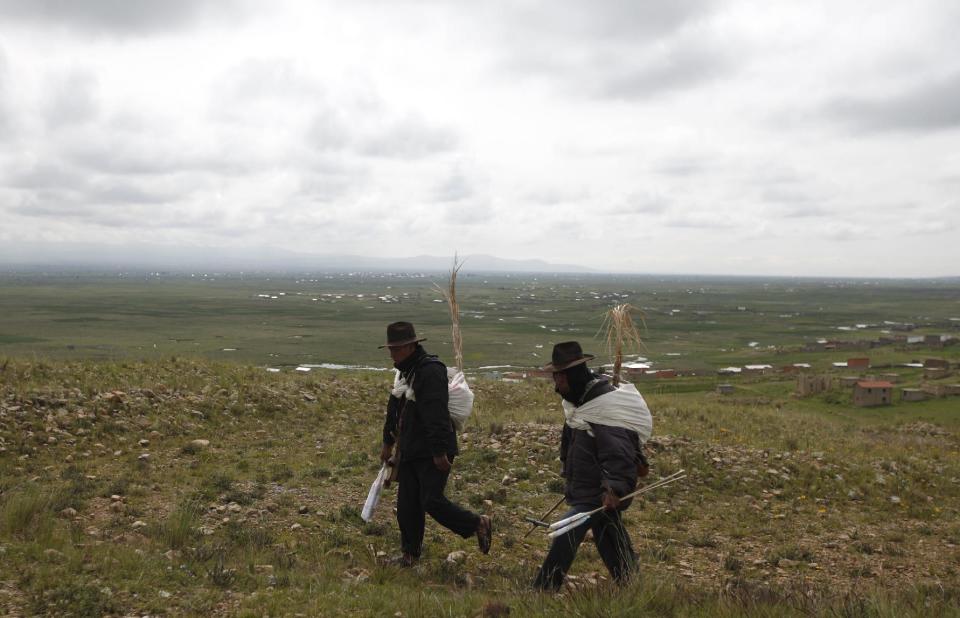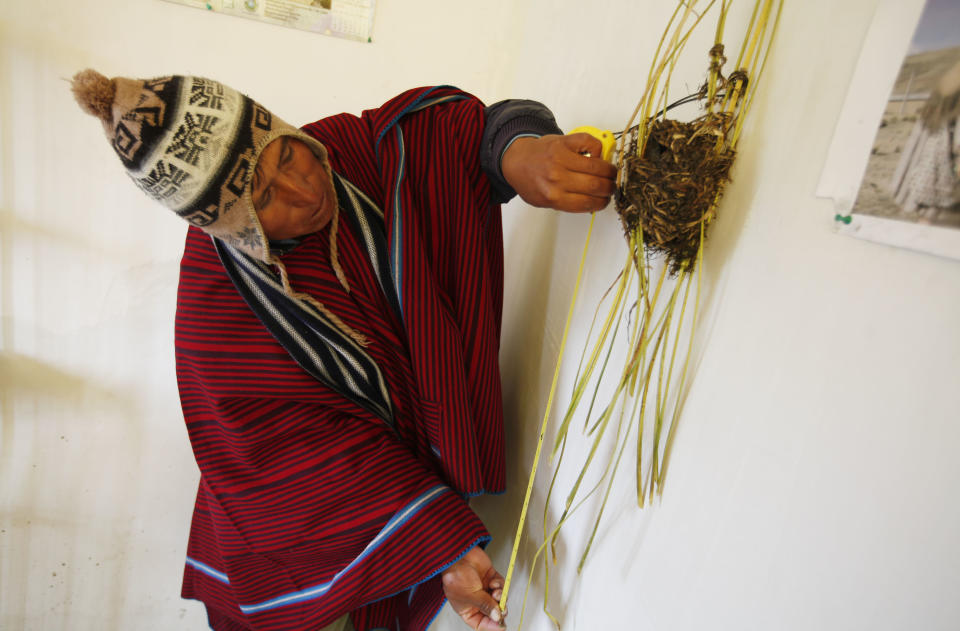Age-old indicators under stress in high Bolivia
CUTUSUMA, Bolivia (AP) — For centuries, farmers in the fragile ecosystems of the high Andes have looked to the behavior of plants and animals to figure out what crops to grow and when.
If reeds dried up in the late summer, rainless weather lay ahead, they believed. If the Andean fox made a howling appearance, abundant rains were thought sure to come.
But increasingly erratic weather that scientists attribute to global warming is rendering their age-old methods less reliable, endangering harvests in a region where life is hard in the best of times.
Experts may scoff at such folk science, but the men and women who till the high mountain soil continue to swear by the traditional indicators, and Bolivia's government has even incorporated them into climate reports provided to farmers when it lacked modern data from meteorological stations.
"They work for me," assures Francisco Condori, 45, after checking the previous night's precipitation on a homemade rain gauge on Lake Titicaca's southern shore, the hills around him shining purple with flowering potato plants.
Condori is a well-heeded font of ancestral knowledge for fellow farmers in these treeless climes frequently punished by frosts, hailstorms and drought.
In the reeds on Titicaca's shore, he points out the height of the nests built by birds known as quilli quilli, a diminutive species similar to hummingbirds. Farmers have long used the locations of those nests as measures of how much the lake will rise and the amount of rainfall to come.
"This year they initially built their nests about 40 centimeters (1.3 feet) above the water level. Then they dismantled them," Condori says. Twice, in fact, did the birds dismantle nests before finally reweaving them at nearly twice their original height.
"We knew it was going to rain a lot," he says.
And so it did, so much so that rivers in the Amazon basin have flooded their banks, submerging thousands of homes. That rain augured well, by contrast, for this Aymara community's potato crop.
Landlocked and poor, Bolivia relies on a weak meteorological reporting system — with just 50 weather stations nationwide. Farming is also decidedly low tech in the mountainous part of the country. Ox-driven plows overwhelmingly outnumber tractors, a far cry from the eastern lowlands, where highly mechanized rice and soy farming yields the bulk of Bolivian agricultural exports.
Condori says the "bio-indicators" he follows most closely have helped reduce agricultural losses 40 percent in Cutusuma and surrounding communities. Scientists, however, stress there are no empirical data to support the beliefs.
The indicators are catalogued in what are known as Pachagrama, registries whose name derives from "Pachamama," the native Andean word for "Mother Earth." Communities compile and share the registry information, which is especially crucial from September to November when the dry season ends and farmers need to know how soon to plant, when the rains will begin and how long they will last.
It's in that season they look for guidance to the southern lapwing, a long-legged plover that likes grasslands. If the female drops her eggs on the crest of a furrow, a lot of rain is expected and farmers will plant potatoes rather than quinoa, which requires less water. But if she deposits them inside the furrow, it supposedly will be a dry year.
The size of the spots on the eggs is another indicator of whether to plant potatoes or quinoa.
"If the spots are big, it's potatoes. If they are small, it's quinoa," Condori says. Lately, however, the birds have been erratic in where they lay their eggs.
Other indicators Condori follows such as wind direction and cloud movement traditionally have told farmers whether frosts are imminent. A strong easterly breeze on March 13 indicates as much, he says.
Reading those signs has become more difficult as climate change alters everything from animal behavior to the weather. There are no scientific studies as yet on how climate change may modify animal behavior used as indicators.
"Yet it is also certain that these meteorological phenomena are occurring in an atmosphere that has warmed by 0.8 degrees (Celsius)," or 1.4 degrees Fahrenheit, since pre-industrial times, said Dirk Hoffmann, a German who heads the nonprofit Bolivian Mountain Institute.
Indeed, the observations of local indigenous coincide with scientific data that show the rainy season is both less predictable and begins later, Hoffman said. "Previously, the rainy period lasted four months. Now it's shorter but the amount of rain has not decreased," he said.
In Bolivia's drier southern high plains, farmers who follow one popular traditional indicator say they were misled this year when the Andean fox did not appear and howl full-throated from the hilltops in August or September. That's a typical indicator of abundant rain, said Jose Luis Quiruchi, a Quechua community leader in the Potosi region, Bolivia's poorest.
Reeds also dried up at that time of year, another traditional indicator of drier weather ahead.
"We expected little rain, but instead the opposite happened," Quiruchi said. Anticipating drier conditions, farmers planted potatoes in low-lying areas. Now, they fear the tubers will become water-logged and rot.
Agronomist Nelson Tapia of the Universidad Mayor de San Simon in Cochabamba says climate change offers some benefits for high-altitude farmers.
They can grow certain fruits and vegetables at higher altitudes, with apricots and corn as well as citrus fruits now growing as high up as 3,000 meters (9,800 feet) in the Cochabamba valley.
However, the negative effects are greater, he said, with highland farmers losing crop variety and planting in shorter cycles.
The director of the government's risk management agency, Lucio Tito, insists the traditional indicators still have their value despite the changing climate.
"They should not be dismissed," he said. "They should be combined with scientific knowledge to form a strategy against climate change. That's what we're doing."
___
Associated Press writer Frank Bajak in Lima, Peru, contributed to this report.




